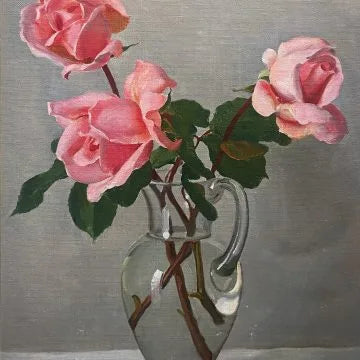

John Bulloch Souter
Still Life of Pink Roses
Oil on canvas, signed lower left
Image size: 11 ¼ x 15 ½ inches (28.5 x 39.5 cm)
Period gilt frame
This still life shows three beautiful roses in a glass vase, painted by the artist circa 1950. It was after World War Two, when Souter returned to live in Aberdeen, that commissions for portraits and copying became scarce. Thus, the artist’s wife encouraged Souter to produce landscapes and still life’s, especially paintings of roses – this is mostly likely to be one of these works.
It is a fine example of early 20th century Scottish floral painting. The work has a brilliant use of colour, with the blush pink tones of the rose petals providing a soft contrast to the greys of the table and wall behind.
Whilst the flowers themselves have been formed using blocks of colour, somewhat reducing each petal to their elementary shapes, attention to realism can be seen in the distortion of the flower stems as viewed through the glass vase. Souter has also created the form of the vase with economy, with a couple of well-placed dashes of white paint to create highlights glistening off the glass.
John Bulloch Souter
John ‘Jack’ Bulloch Souter, also known. as J.B. Souter, was a Scottish painter, sculptor and illustrator.
Born in Aberdeen in northeast Scotland, he was a skilled pupil at Ferryhill School, Gray’s School of Art, and then at the Allan Fraser School in Arbroath. He won the Byrne Travelling Scholarship awarded by the Scottish Education Department which enabled him to comfortably tour the European continent. During this continental tour, he was purportedly much impressed by Diego Velázquez, Johannes Vermeer, and Jean-Baptiste-Siméon Chardin.
Following the outbreak of World War I, Souter served in the Gordon Highlanders and the Royal Army Medical Corps. Upon returning to civilian life, he married Christian Grace Reid and relocated to London. During the post-war period he garnered a reputation as a talented portraitist and his many subjects included such personalities as Gladys Cooper, Ivor Novello, and Fay Compton.
Souter exhibited his creations at Redfern Gallery, the Fine Art Society, Royal Scottish Academy and the Royal Academy’s Summer Exhibition where his notorious painting The Breakdown was exhibited in 1926 to great controversy. Within days of its exhibition, the British Colonial office contacted the Royal Academy and demanded the immediate removal of the picture as a perceived threat to the British empire. Following negative attacks in the national and world press, Souter’s wife convinced him to destroy the painting—his greatest work—which he reluctantly assented to do, however he clandestinely retained his preparatory drawings.
Amid the chaos and nightly bombing of World War II, he laboured in the Censorship Department as a translator but spent the majority of his time restoring paintings at Windsor Castle. In 1952, he retired to Aberdeen where, ten years later, despite his failing eyesight, he drew upon his earlier sketches to reconstruct his original work The Breakdown nearly thirty years after its destruction. Souter remained in Aberdeen until his death in 1972.
His work remains in various private and public collections, including Aberdeen Art Gallery, Southampton Art Gallery and the Dublin National Gallery.



